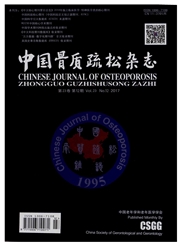

 中文摘要:
中文摘要:
临床上常用糖皮质激素(glucocorticoids,GCs)来治疗多种疾病,但GCs诱导的骨质疏松症(glucocorticoid-induced osteoporosis,GIO)是其严重副作用之一。目前已知高剂量GCs可以抑制成骨细胞(osteoblast,OB)的增殖和分化,诱导OB的凋亡,减少骨形成,而导致骨质疏松(osteoporosis,OP)。而低剂量GCs体外却刺激了OB的增殖和分化。在动物体内实验中发现:一定的条件下,GCs在未影响松质骨的情况下,即可造成皮质骨骨量的丢失,这种GCs的双向作用是由于体内骨转移和GCs对骨组织作用的部位特异性造成的,目前还没有统一的结论。笔者主要从临床、实验和机理这3方面的研究人手,综述GCs对成骨的双向作用与OP之间关系的研究现状,以便更深入地了解GIO的发病机理,并为临床合理使用该类药物提供指导意见。
 英文摘要:
英文摘要:
Glucocorticoid (GCs) is often utilized as a therapy for various diseases in the clinic. But glucocorticoid-induced osteoporosis(GIO) is one of the severe side effects. High doses of GCs are known to inhibit osteoblasts (osteoblast, OB) proliferation and differentiation, and induced apoptosis of osteoblasts, so that bone formation decreased, while leading to osteoporosis. The low-dose GCs in vitro can stimulate osteoblasts proliferation and differentiation. It can be found that in animal experiments GCs did not affect the cancellous bone in the circumstances, but can result in the loss of cortical bone mass in certain conditions, this two-way role of GCs which is due to maintain cancellous bone is at the expense of cortical bone in vivo, or because of GCs on the bone by site-specific, and there is no uniform conclusions. This article reviews the bidirectional regulative function of bone by glucocorticoids and studies the relationship between the role and osteoporosis mainly from three areas of clinical, experimental and mechanism. It is favorable to further understand the pathogenesis of GIO and provide guidance for clinical rational use of GCs.
 同期刊论文项目
同期刊论文项目
 同项目期刊论文
同项目期刊论文
 Effects of Alendronate and Strontium Ranelate on Cancellous and Cortical Bone Mass in Glucocorticoid
Effects of Alendronate and Strontium Ranelate on Cancellous and Cortical Bone Mass in Glucocorticoid 期刊信息
期刊信息
